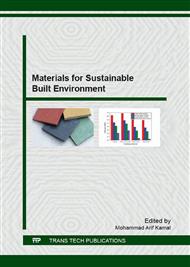[1]
Byrd, H., Energy and Ecology: A View of Malaysia Beyond 2020. 2008, Geowrgtown: University Science Malaysia Press.
Google Scholar
[2]
Al-Tamimi, N.A. and S.F.S. Fadzil, The Potential of Shading Devices for Temperature Reduction in High-Rise Residential Buildings in the Tropics. Procedia Engineering, 2011. 21(0): pp.273-282.
DOI: 10.1016/j.proeng.2011.11.2015
Google Scholar
[3]
Al-Tamimi, N.A., S.F. Syed Fadzil, and W.M. Wan Harun, The Effects of Orientation, Ventilation, and Varied WWR on the Thermal Performance of Residential Rooms in the Tropics. Journal of Sustainable Development, Canada, 2011. 4(2): pp.142-149.
DOI: 10.5539/jsd.v4n2p142
Google Scholar
[4]
Rickwood, P., G. Glazebrook, and G. Searle, Urban Structure and Energy - A Review. Urban Policy and Research, 2008. 26(1): pp.57-81.
DOI: 10.1080/08111140701629886
Google Scholar
[5]
Liping, W., H. Wong Nyuk, and S. Li, Facade design optimization for naturally ventilated residential buildings in Singapore. Energy and Buildings, 2007. 39(8): pp.954-961.
DOI: 10.1016/j.enbuild.2006.10.011
Google Scholar
[6]
Seung, B.L., I.B. Jeung, and H.R. Young, A Study on Cooling Energy Savings Potential in High-Rise Residential Complex Using Cross Ventilated Double Skin Facade Journal of Asian Architecture and Building Engineering, 2004. 3(2): pp.275-282.
DOI: 10.3130/jaabe.3.275
Google Scholar
[7]
Bojic, M., F. Yik, and P. Sat, Energy performance of windows in high-rise residential buildings in Hong Kong. Energy and Buildings, 2002. 34(1): pp.71-82.
DOI: 10.1016/s0378-7788(01)00079-2
Google Scholar
[8]
Cheung, C.K., R.J. Fuller, and M.B. Luther, Energy-efficient envelope design for high-rise apartments. Energy and Buildings, 2005. 37(1): pp.37-48.
DOI: 10.1016/j.enbuild.2004.05.002
Google Scholar
[9]
Al-Saadi, S.N., Envelope design for thermal comfort and reduced energy consumption in residential buildings, in Architectural Engineering Dept. 2006, King Fahd University of Petroleum and Minerals: SAK.
Google Scholar
[10]
Carmody, J., et al., Residential Windows: A Guide to New Technologies and Energy Performance. 2007, Third Edition. New York. 247.
Google Scholar
[11]
Krarti, M., P.M. Erickson, and T.C. Hillman, A simplified method to estimate energy savings of artificial lighting use from daylighting. Building and Environment, 2005. 40(6): pp.747-754.
DOI: 10.1016/j.buildenv.2004.08.007
Google Scholar
[12]
Yu, J., C. Yang, and L. Tian, Low-energy envelope design of residential building in hot summer and cold winter zone in China. Energy and Buildings, 2008. 40(8): pp.1536-1546.
DOI: 10.1016/j.enbuild.2008.02.020
Google Scholar
[13]
Ibrahim, N. and A. Azni Zain, A Simple Prediction Tool for Energy Savings due to Daylighting in Malaysia. ISESCO: Science and Technology Vision, 2006. 2(1): pp.25-29.
Google Scholar
[14]
Sammy, D., et al., Design strategies for new buildings (non-domestic). 2004, Selangor, Malaysia: MEWC.
Google Scholar
[15]
MMD, Records of Meteorological Data. 2009, Malaysian Metrological Department.
Google Scholar
[16]
Ji, Y., K.J. Lomas, and M.J. Cook, Hybrid ventilation for low energy building design in south China. Building and Environment, 2009. 44(11): pp.2245-2255.
DOI: 10.1016/j.buildenv.2009.02.015
Google Scholar
[17]
Samirah Abdul, R. and K.S. Kannan, Air flow and thermal comfort simulation studies of wind ventilated classrooms in Malaysia. Renewable Energy. 8(1-4): pp.264-266.
DOI: 10.1016/0960-1481(96)88859-8
Google Scholar
[18]
Chua, K. and S. Chou, Evaluating the performance of shading devices and glazing types to promote energy efficiency of residential buildings. Building Simulation, 2010. 3(3): pp.181-194.
DOI: 10.1007/s12273-010-0007-2
Google Scholar
[19]
Guan, L., The Implication of global warming on the energy performance in indoor Thermal environment of Air-Conditioned office buildings in Australia in Faculty of Built Environment and Engineering. 2006, Queensland University of Technology.
Google Scholar
[20]
Al-Tamimi, N.A. and S.F. Syed Fadzil, Thermal Performance Analysis for Ventilated and Unventilated Glazed Rooms in Malaysia (Comparing Simulated to Field Data). Indoor and Built Environment, 2011. 20(5): pp.534-542.
DOI: 10.1177/1420326x11411235
Google Scholar
[21]
Lam, J.C. and D.H.W. Li, An analysis of daylighting and solar heat for cooling-dominated office buildings. Solar Energy, 1999. 65(4): pp.251-262.
DOI: 10.1016/s0038-092x(98)00136-4
Google Scholar
[22]
IES<VE>. Integrated environmental solutions <Virtual Environment>. available through: http: /www. iesve. com 2010 13 Dec 2010].
Google Scholar
[23]
Haberl, J.S. and T.E. Bou-Saada, Procedure for calibrating hourly simulation models to measured building energy and environmental data. Journal of Solar Energy Engineering, 1998. 120(1): p.193–208.
DOI: 10.1115/1.2888069
Google Scholar
[24]
Sreshthaputra, A., J. Haberl, and M.J. Andrews, Improving building design and operation of a Thai Buddhist temple. Energy and Buildings, 2004. 36(6): pp.481-494.
DOI: 10.1016/j.enbuild.2003.12.010
Google Scholar
[25]
Judkoff, R.D. and J.S. Neymark, Procedure for Testing the Ability of Whole Building Energy Simulation Programs to Thermally Model the Building Fabric. Journal of SolarEnergy Engineering, 1995. 117(1): pp.7-5.
DOI: 10.1115/1.2847754
Google Scholar
[26]
Al-Tamimi, N.A., Impact of Building Envelope Modifications on the Thermal Performance of Glazed High-Rise Residential Buildings in the Tropics, in Unpublished PhD. Thesis, Arch. Dept. 2011, University Sience Malaysia: Malaysis. p.232.
Google Scholar


